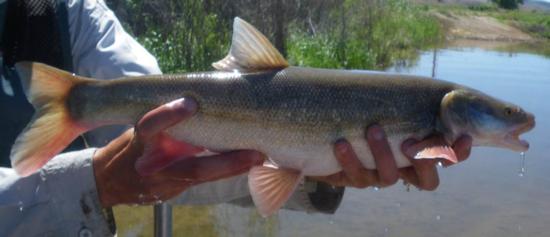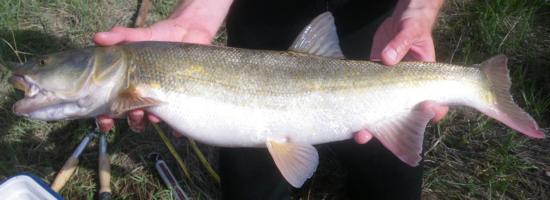Colorado pikeminnow
-
Scientific NamePtychocheilus lucius
-
NativeYes
-
Identification
 Colorado pikeminnow, adult, right side. Photo by Cameron T. Wilcox, Colorado State University.
Colorado pikeminnow, adult, right side. Photo by Cameron T. Wilcox, Colorado State University. Colorado pikeminnow, adult, left side. Photo by Cameron T. Wilcox, Colorado State University.
Colorado pikeminnow, adult, left side. Photo by Cameron T. Wilcox, Colorado State University.- Large, up to 2 m TL
- Long body, flattened tapered head, deeply forked tail
- Mouth large, toothless; maxilla extends back behind front edge of eye
- Coloration: body silvery, larger individuals dark on the back, white to yellow on sides and underside
- Juveniles: dark spot at base of tail
- Spawning adults: silvery on sides, gold flecks, cream colored underside
- Breeding males develop tiny tubercles on head, and row of tubercles along the side
- Fin rays: dorsal 9, anal 9, pectoral 14-16, pelvic 8-10
- Lateral line scales: 76-97, 18-23 rows above lateral line
- Pharyngeal teeth: 2,5-4,2
-
Life History
Colorado pikeminnow, formerly known as Colorado squawfish, are extinct in California and absent from the lower Colorado River drainage which they historically occupied. They are listed federally and in California as an endangered species and are only found in small numbers in the upper mainstem Colorado River and tributaries such as the Green River, Yampa River, and San Juan River. Juvenile Colorado pikeminnow live in shallow edge habitat and backwaters. They feed on aquatic invertebrates, and shift to feeding on fish as they reach 100 mm TL. Larger fish may move actively through the river, but still tend to inhabit backwaters and areas with slower currents and abundant prey. Colorado pikeminnow mature after age 6, at 430-500 mm TL, and may live to 30 years. They may make long spawning migrations of over 200 km, starting in early summer. They spawn in late June to early August in fast-flowing rapids in deep canyons where the eggs stick to the gravel substrate. Eggs hatch in 3-6 days and larvae drift downstream over 100 km to rearing habitat.
-
Links to Other ResearchN / A

